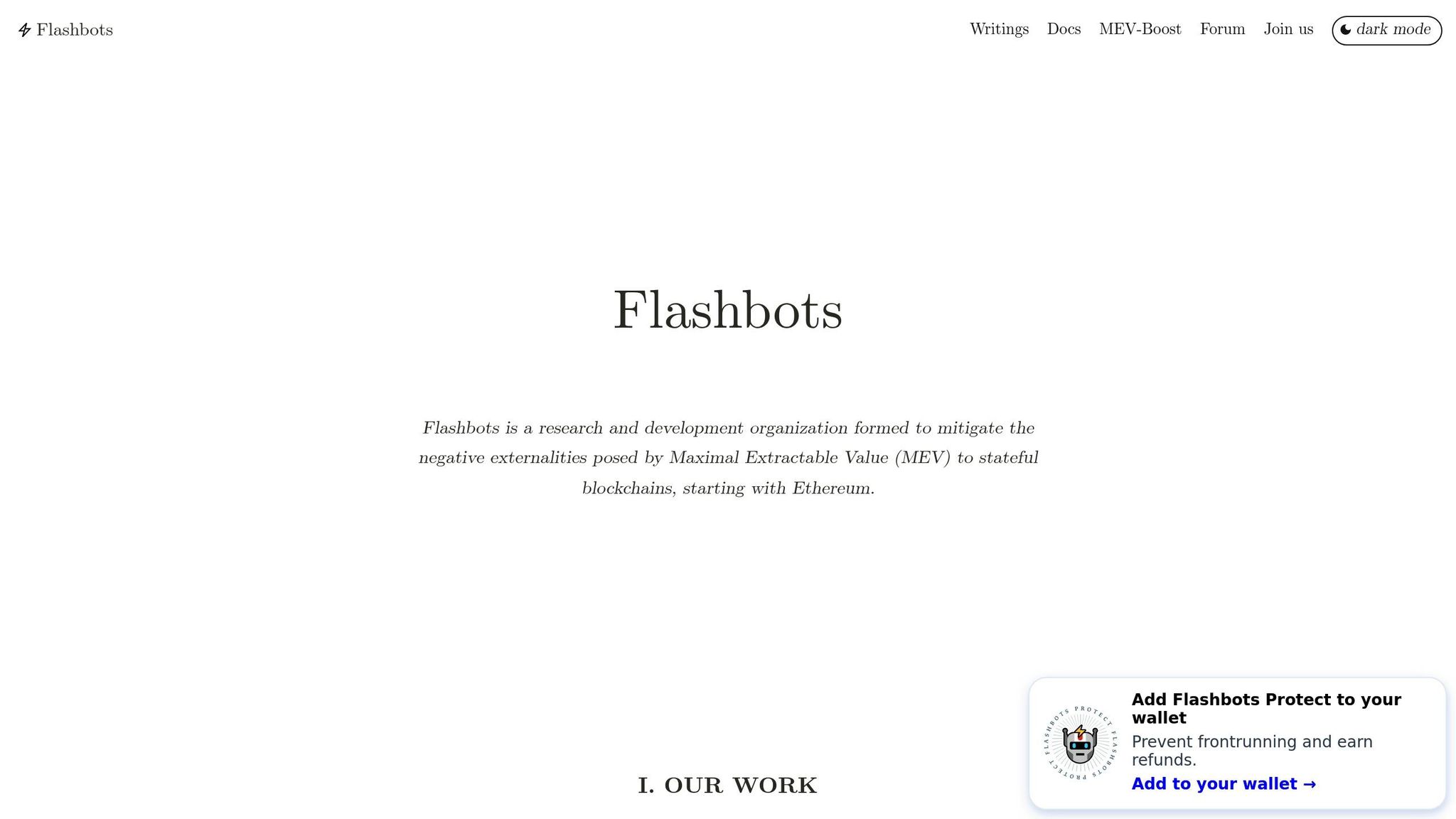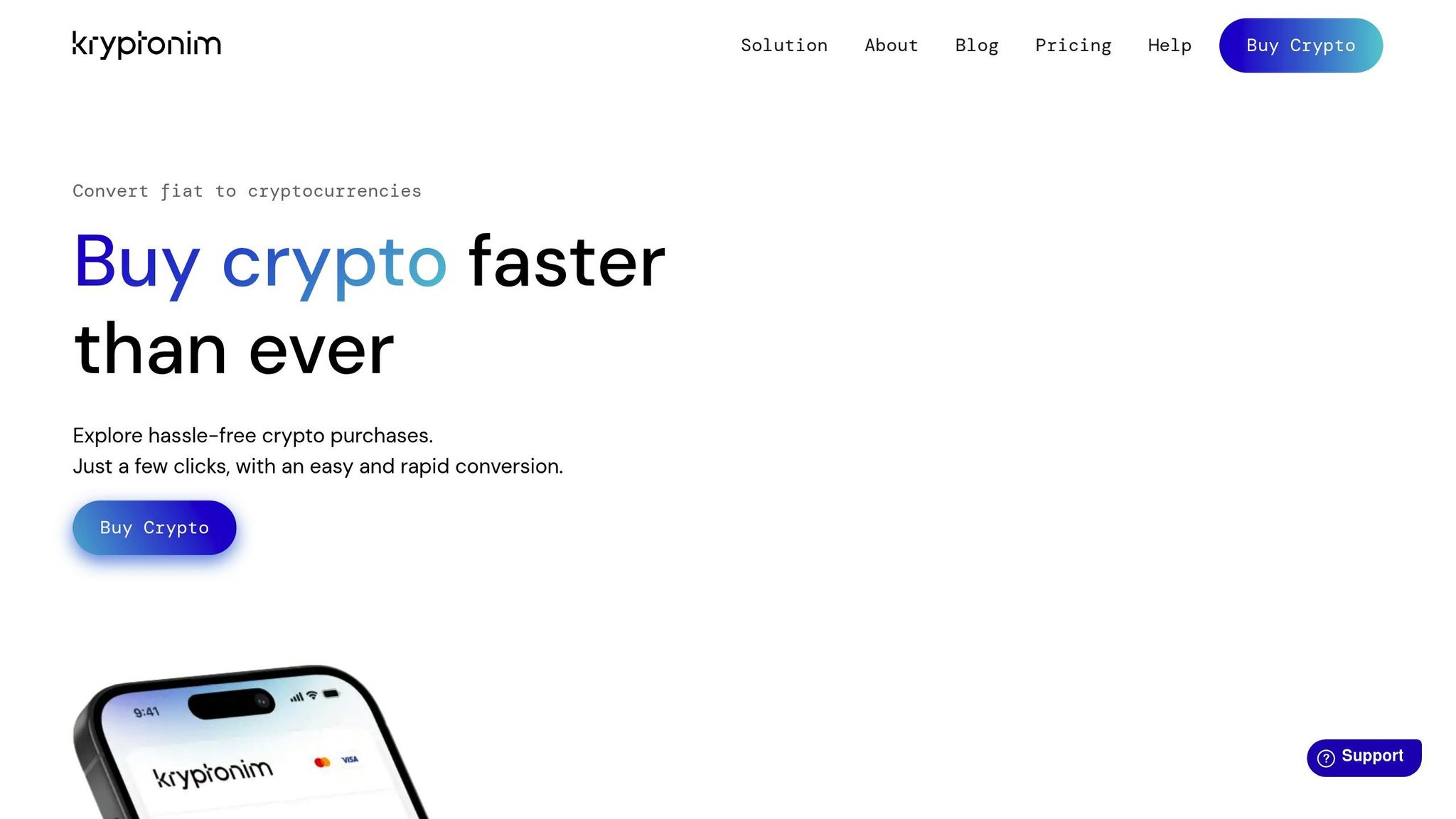How does MEV work in blockchain trading?
Explore how Maximal Extractable Value (MEV) affects blockchain trading, increasing costs and impacting execution quality while offering protection strategies.

MEV, or Maximal Extractable Value, refers to the profit gained by reordering, including, or excluding transactions within a blockchain block. It significantly impacts traders by increasing costs, creating delays, and reducing execution quality. MEV exploits arise from the way blockchain transactions are processed, particularly in the mempool, where unconfirmed transactions are vulnerable to manipulation.
Key points to know:
- What it is: MEV allows miners, validators, and bots (searchers) to prioritize or reorder transactions for profit.
- Common tactics: Includes sandwich attacks (manipulating token prices) and arbitrage (exploiting price differences across platforms).
- Impact on traders: Leads to higher gas fees, slippage, and unpredictable costs.
- How to protect yourself:
- Use tools like Flashbots Protect to shield transactions.
- Set tight slippage tolerances.
- Trade in high-liquidity pools or during low network congestion.
- Consider MEV protection RPCs or centralized platforms like Kryptonim for simpler solutions.
Understanding MEV and using protection strategies can help reduce hidden costs and improve trading outcomes.
How MEV Works
MEV (Maximal Extractable Value) hinges on the strategic ordering of transactions, allowing block producers and searchers to exploit technical gaps for additional profit. This process directly influences trading costs and execution quality.
Transaction Ordering and Mempools
In the mempool - the waiting area for unconfirmed transactions - certain players manipulate transaction positioning to their advantage. Block producers, such as miners or validators, reorder transactions in a way that maximizes their profits. By carefully arranging the sequence of transactions, they can extract extra value.
MEV searchers, on the other hand, deploy automated trading bots to scan the mempool for lucrative opportunities. Once they spot a valuable transaction, they strategically submit their own transactions with adjusted gas fees to position themselves before or after the target trade in the final block order.
According to EigenPhi, arbitrage dominates MEV activity, generating $4.4 million in profits over 30 days in May 2024. Sandwich attacks, another common tactic, brought in $1.2 million during the same period.
Here’s how these strategies work in practice:
- Sandwich Attacks: Imagine a bot detecting a large ETH/USDC swap. It places a buy order just before the swap, driving up the price, and then sells immediately after the swap when the price drops. This "sandwiching" captures value from the price movement.
- Arbitrage: A bot might notice a token's price rising on Uniswap due to a large purchase. It quickly buys the token on SushiSwap at a lower price and sells it on Uniswap at the inflated rate, locking in a nearly risk-free profit.
These tactics not only shift profits toward MEV operators but also add unexpected costs to standard transactions.
MEV as Hidden Costs
The techniques used by MEV operators effectively act as a hidden tax on blockchain users. These hidden costs show up in several ways:
- Increased Slippage: You might buy at a higher price or sell at a lower price than anticipated due to MEV activity.
- Higher Gas Fees: Bots competing for transaction priority can drive up gas costs.
- Network Congestion: The activity of MEV bots often clogs the network, causing delays and further increasing fees.
The scale of MEV’s impact is staggering. By the end of 2024, global MEV activity is projected to exceed $1.1 billion, with sandwich attacks alone making up about 66% of MEV on Ethereum. These attacks are estimated to generate nearly $1 million in weekly profits for searchers.
Beyond financial losses, MEV bots also burden blockchain infrastructure. For example, on Solana, bots occupy 40% of block space while contributing only 7% of transaction fees. Ethereum Layer-2 solutions like Base and Optimism face similar issues, with bots consuming over half of the available gas.
Ultimately, every trade carries the risk of being affected by these sophisticated MEV tactics, adding unseen costs to your transactions and straining the system’s resources.
Types of MEV Attacks
Building on the mechanics of MEV, these attacks showcase how transaction ordering can be exploited for financial gain. By manipulating transaction sequences, attackers extract value, often at the expense of traders who face higher fees or worse trade outcomes.
Front-Running Attacks
Front-running involves MEV bots scanning the mempool for large transactions and then outbidding them by offering higher gas fees to ensure their transactions are processed first. For example, when user 0x3a7822 attempted to trade 2 ETH for $BOB tokens, the bot "jaredfromsubway.eth" jumped ahead by purchasing $BOB first. This maneuver reduced the number of tokens the user received and earned the bot a profit of roughly 0.1 ETH.
Sandwich Attacks
In a sandwich attack, bots strategically place transactions both before and after a target trade to manipulate market prices for profit. Imagine a trader like Bessie trying to buy 4,000 COW tokens with 1 ETH on Uniswap. An attacker could force her transaction to execute at a higher price, such as 1.1 ETH, pocketing approximately 0.1 ETH in profit.
Other MEV Methods
MEV strategies extend beyond front-running and sandwich attacks, employing techniques like arbitrage, liquidation attacks, and just-in-time liquidity provision. Take one documented case involving Maple Finance's governance token (MPL): an MEV bot swapped 0.00005 WETH for 17.06886 MPL tokens on Uniswap V2, then immediately traded those tokens for 0.0544 ETH on a Balancer liquidity pool. After covering 0.0347 ETH in priority fees, the bot walked away with a profit of 0.015 ETH.
While certain tactics, such as arbitrage, can help align prices across platforms, they often come at a cost to regular traders - leading to worse price execution and higher transaction fees. These methods highlight why understanding MEV is crucial for traders looking to protect their transactions.
How MEV Affects Traders
MEV has a profound impact on the trading environment, influencing casual traders and seasoned operators in different ways. By understanding these effects, you can refine your approach and better navigate the challenges MEV introduces.
MEV Risks for Traders
For everyday traders, MEV can turn potential profits into losses. The most immediate concerns stem from rising transaction costs and unpredictable trade outcomes.
Higher Gas Fees and Network Congestion
MEV bots compete fiercely for profitable opportunities by driving up gas fees, making transactions more expensive for everyone. During peak activity, this competition can send gas fees soaring into the hundreds of gwei. The result? Slower transaction speeds and significantly higher costs for regular users.
Price Slippage and Poor Execution
When you place a trade, MEV bots can interfere by manipulating the price before your transaction is finalized. A common tactic is the sandwich attack: bots purchase tokens just before your trade (pushing the price up) and sell immediately after (dropping the price back down). These attacks have collectively cost traders millions of dollars.
Unpredictable Trading Costs
MEV extraction drains value from everyday traders, adding another layer of unpredictability to trading costs.
MEV Pros and Cons
While MEV creates challenges, it also contributes to certain aspects of market efficiency. The impact, however, varies depending on who you are in the trading ecosystem:
| Group | Benefits | Drawbacks |
|---|---|---|
| Regular Traders | Better price consistency across exchanges through arbitrage | Higher transaction costs, price slippage, and failed transactions |
| MEV Searchers | Profitable opportunities and automated income | High technical barriers, intense competition, and capital demands |
| Block Producers | Additional revenue beyond standard block rewards | Risks of centralization and ethical concerns |
Market Efficiency vs. User Experience
MEV activities, like arbitrage, help align prices across decentralized exchanges by addressing price discrepancies. For instance, one case showed an investor turning 1,000 ETH into 1,045 ETH by exploiting a price difference between Uniswap and Sushiswap's ETH/DAI pair. While this type of efficiency benefits the broader market, it often comes at the expense of regular users, as well-funded players with advanced tools dominate the space.
Emerging Opportunities
Some platforms are beginning to share MEV profits with traders. For example, MEV rebates allow users to reclaim a portion of the extracted value, and new tools make it easier for less technical traders to pool resources and participate in MEV activities. However, these solutions are still evolving, and beginners remain vulnerable. Without proper safeguards, predictable trading patterns and a lack of defensive strategies can lead to significant losses.
With the risks and opportunities outlined, the next step is learning how to protect your trades from MEV. Stay tuned for strategies designed to help you navigate this complex landscape.
sbb-itb-0796ce6
How to Protect Yourself from MEV
Discover practical tools and strategies to safeguard your transactions from MEV attacks.
Using Flashbots for MEV Protection

Flashbots Protect is one of the most effective tools available to shield your transactions from MEV exploitation. It creates a private transaction pool, keeping your trades hidden from front-running and sandwich bots until they’re safely included in a block.
"Flashbots Protect is a cheaper and safer way to transact on Ethereum. It protects your transactions from frontrunning and gives you refunds on gas fees and MEV." - Flashbots Docs
How Flashbots Protect Works
This system screens your transactions and shares only those requiring MEV protection with the Flashbots Builder.
Setting Up Flashbots Protection
To activate Flashbots Protect, add the Flashbots Protect RPC (rpc.flashbots.net) to your wallet. For quicker transaction processing, use the "fast" option by setting your RPC to rpc.flashbots.net/fast.
Key Benefits and Results
Since 2021, Flashbots has protected over 2.1 million users and secured $43 million in DEX volume. If your transaction generates MEV or pays high priority fees, you can even receive up to 90% of the generated MEV back through MEV-Share. Additionally, transactions are only added to blocks if they don’t revert, ensuring you’re not charged fees for unsuccessful trades.
Tips for Using Flashbots Protect
Avoid switching RPCs mid-transaction. Doing so can expose your transaction to the public mempool, undermining the protection mechanism.
Simple MEV Protection Tips
Here are additional strategies to reduce your exposure to MEV:
- Set Tight Slippage Tolerances: Lower your slippage tolerance to limit opportunities for MEV bots to manipulate your trade’s price. Instead of the default 3% slippage on many DEXs, aim for 1% or even 0.5% when trading liquid pairs.
- Choose High-Liquidity Pools: Trading in pools with significant liquidity can reduce your vulnerability to arbitrage by MEV bots.
- Use MEV Protection RPCs: Install an MEV protection RPC endpoint, such as MEV Blocker, to conceal your transactions from the public mempool.
- Consider Intent-Based Trading: Platforms like CoW Protocol offer built-in MEV protection through delegated trade execution, batch auctions, and uniform clearing prices. These systems rely on solvers to execute trades, shielding you from price manipulation.
- Time Your Trades Strategically: Trading during periods of low network congestion can help minimize MEV exposure.
For those who prefer simplicity, centralized platforms may offer a more accessible solution.
Trade Safely with Kryptonim

If managing these strategies feels overwhelming, Kryptonim provides a secure and straightforward alternative. This centralized platform eliminates many MEV concerns by avoiding the public mempool entirely. Instead, transactions are processed through traditional order books with transparent pricing.
Clear Pricing Structure: Kryptonim charges a flat 2% fee for EU users and 4% for users in other regions, with no hidden fees or MEV-related price manipulation.
Beginner-Friendly Design: With a simple interface, no account creation required, and an easy verification process, Kryptonim is perfect for newcomers who want to avoid the complexities of configuring MEV protection tools or navigating DeFi protocols.
When to Use Kryptonim vs. DEXs: Kryptonim is ideal for straightforward fiat-to-crypto transactions, especially for larger amounts where MEV protection is critical. Once you’re more experienced, you can explore decentralized exchanges and apply the additional MEV protection strategies outlined above.
Conclusion
MEV (Maximal Extractable Value) is a critical concept for crypto traders to grasp, especially as global MEV activity has surpassed $1.1 billion by the end of 2024. Sandwich attacks alone make up about 66% of all MEV activity on Ethereum. With this understanding, you’re now equipped with strategies to safeguard your trades - whether it’s using Flashbots Protect for DeFi transactions, setting tighter slippage tolerances, or opting for centralized platforms like Kryptonim for more straightforward trading.
These examples highlight the risks MEV poses and why having protection strategies in place is essential for maintaining profitability in trading.
As MEV protection tools continue to evolve, staying updated on the latest advancements is key. Use private RPCs when trading on decentralized exchanges, and consider platforms that simplify these challenges for you. By balancing profit potential with protection against hidden costs, you can enhance your trading efficiency.
To recap, implement MEV safeguards such as configuring your wallet for protection, refining your trading practices, or exploring secure platforms designed to tackle MEV issues. In the fast-paced world of blockchain, informed trading decisions can significantly impact your cost savings and overall execution quality.
FAQs
How can I protect my blockchain transactions from MEV attacks?
To protect your transactions from MEV (Maximal Extractable Value) attacks, here are a few practical tips:
- Set a low slippage tolerance: This helps limit how much the price can shift during your transaction, reducing the risk of manipulation.
- Use private transaction pools or protected RPC endpoints: These tools keep your transactions out of public mempools, making them less visible to attackers.
- Consider tools like Flashbots or encrypted transaction methods: These are specifically designed to reduce the chances of MEV-related risks.
Taking these steps can help you avoid front-running or sandwich attacks, offering a safer trading experience in decentralized finance (DeFi) platforms.
How do sandwich attacks and arbitrage affect my trading costs and execution quality?
Sandwich attacks and arbitrage can take a toll on your trading experience by driving up costs and lowering the quality of trade execution. In a sandwich attack, bad actors manipulate asset prices by strategically placing trades both before and after yours. This results in increased slippage, meaning you could end up paying more or selling for less than you anticipated.
These tactics can also disrupt the stability of your trades, leading to unfavorable price movements that eat into your potential profits. To guard against these risks, consider using tools specifically designed to counter MEV strategies and keep a close eye on settings like slippage tolerance to stay in control.
Can MEV have positive effects on the market, and how are these balanced against its downsides for individual traders?
Understanding MEV and Its Impact
Maximal Extractable Value (MEV) can play a role in improving market dynamics. By encouraging price alignment and ensuring essential processes like liquidations run smoothly, MEV contributes to greater efficiency. This, in turn, helps maintain stability and liquidity within the decentralized finance (DeFi) ecosystem.
That said, MEV isn't without its downsides - especially for individual traders. Practices like front-running or sandwich attacks can result in substantial losses, making MEV a double-edged sword. To address these challenges, tools like Flashbots have been introduced. These tools aim to minimize harmful MEV activities and promote fairer trading conditions.
For traders, understanding how MEV works and implementing strategies to protect against its risks is crucial for navigating the DeFi space effectively.
